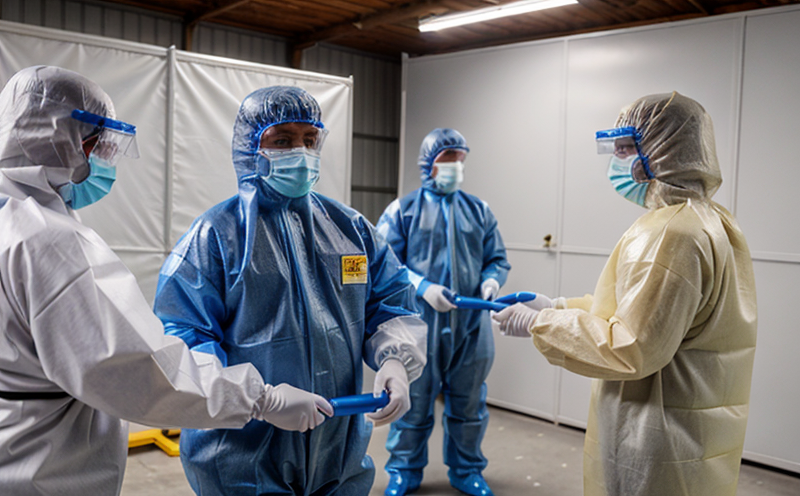ISO 9151 Heat transmission through flame exposure Performance test
The ISO 9151 standard is designed to evaluate the heat transfer properties of protective clothing under flame exposure. This essential testing procedure ensures that the garments are suitable for use in environments where workers may be exposed to fire hazards, thus safeguarding against burn injuries and enhancing occupational safety.
Protective clothing subjected to flame exposure can experience significant temperature changes, leading to heat transfer through its layers. Accurately measuring these transfers is crucial for designing effective garments that meet regulatory requirements and provide reliable performance under real-world conditions.
The ISO 9151 test method involves subjecting a sample of the protective clothing to a controlled flame exposure in a specially designed apparatus. The apparatus simulates the heat transfer process by measuring temperature rise at various points on the specimen. This data is then used to calculate the heat transmission through the material, which is expressed as Heat Transfer Coefficient (HTC).
Understanding the HTC value helps manufacturers and users assess how effectively a garment can manage heat during emergencies. The lower the HTC, the better the thermal insulation properties of the clothing, reducing the risk of burns for workers.
The test setup typically includes:
- A controlled flame exposure source
- Thermocouples or thermistors to measure temperature at specific points on the specimen
- An apparatus that ensures consistent and reproducible testing conditions
- Data acquisition systems for recording thermal data during the test
The test procedure involves several steps:
- Preparation of the protective clothing sample according to ISO 9151 standards.
- Positioning the sample in the testing apparatus with appropriate supports and clamps.
- Application of a controlled flame exposure for a specified duration.
- Recording temperature data at predefined intervals during and after the test.
- Analysis of the recorded data to compute the HTC values.
The results provide critical insights into the performance characteristics of protective clothing, aiding in continuous improvement for better safety standards. Compliance with this standard ensures that the garments are not only effective but also meet stringent quality and safety benchmarks set by international regulatory bodies.
Why It Matters
The importance of ISO 9151 testing cannot be overstated, especially in industries where workers frequently encounter fire hazards. Protective clothing serves as a critical barrier against heat and flame, minimizing the risk of severe burns. By accurately measuring the heat transfer properties through these garments, this test ensures that they perform optimally under stress conditions.
Occupational safety is paramount in high-risk environments such as firefighting, manufacturing, welding, and construction. Workers exposed to fire hazards need reliable protection that can withstand intense temperatures without compromising their safety. The ISO 9151 heat transmission test plays a vital role in validating the thermal performance of protective clothing, thereby enhancing worker safety.
In addition to ensuring personal safety, this testing also supports broader industrial objectives such as:
- Enhanced worker confidence and well-being
- Reduced insurance costs due to fewer burn-related incidents
- Better compliance with international occupational health and safety standards
- Innovation in protective clothing design for improved performance
Eurolab Advantages
At Eurolab, our commitment to excellence in textile testing is reflected in the comprehensive range of services we offer. When it comes to ISO 9151 heat transmission through flame exposure performance tests, our expertise ensures accurate and reliable results.
- State-of-the-Art Facilities: Our laboratories are equipped with advanced testing equipment that adheres strictly to international standards.
- Experienced Professionals: Our team of skilled technicians and engineers is certified in conducting ISO 9151 tests, ensuring precision and accuracy in every test performed.
- Comprehensive Reporting: We provide detailed reports that not only include the HTC values but also offer insights into potential improvements for garment design.
- Certified Compliance: All our testing methods are meticulously aligned with ISO and other relevant international standards, ensuring complete compliance.
We understand the critical nature of this test in safeguarding worker safety. Our services go beyond just conducting tests; we also offer guidance on material selection, design optimization, and continuous improvement to enhance performance further.
Environmental and Sustainability Contributions
The ISO 9151 heat transmission test contributes positively to environmental sustainability by promoting the development of protective clothing that minimizes thermal stress on workers. Here are some ways in which this testing supports broader sustainability goals:
- Reduction in Burn Injuries: By ensuring effective protection against fire hazards, fewer burn injuries occur, leading to less medical resource consumption and lower environmental impact.
- Innovation for Safer Materials: The test drives the research and development of safer materials that can withstand high temperatures without compromising on worker safety.
- Better Resource Management: More efficient protective clothing leads to better resource management, reducing waste in production processes.





